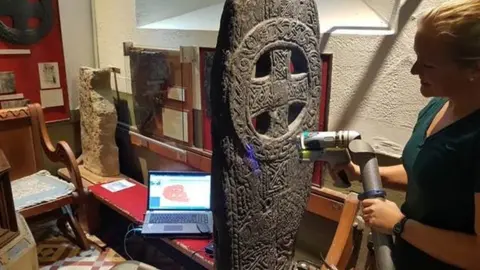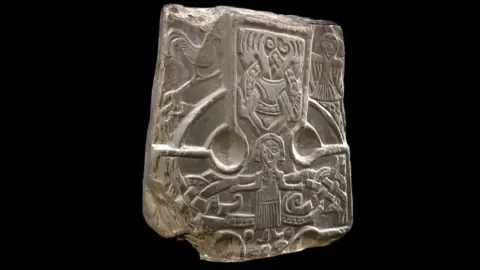'Unprecedented' project to catalogue Manx medieval crosses
 MNH
MNHA painstaking project to scan and catalogue 210 medieval stone crosses has been completed on the Isle of Man.
Manx National Heritage said the crosses, grave markers and memorials were "incredibly important" and date as far back as 500AD.
A spokesman said the carved stones were of "international significance to archaeologists and historians".
It is hoped the online resource, available to the public, will help experts to preserve the stones.
MNH conservation manager Christopher Weeks said it would make the stones "more accessible than ever before."
 MNH
MNHHe said: "We need to know whether the crosses are deteriorating, but first we had to find a way to record them in fine detail.
"What we have ended up doing is unprecedented in its scale and ambition."
The stones, which appear all around the island, range from simple grave markers to intricately inscribed monuments.
Some are carved with letters of the Ogham, Latin and Runic alphabets, while others include personal and place names and scenes from Christian and Norse mythology.
They are one of the greatest legacies of early Christian faith and Viking settlement on the Isle of Man.
 MNH
MNHAn MNH spokeswoman said the laser scanning technology had captured the crosses to a resolution of one tenth of a millimetre - exceeding the guidance from Historic England.
Inspector of ancient monuments Andrew Johnson said the crosses were a source of "great local interest and pride to communities up and down the Isle of Man".
He added: "They are also of international significance for what they tell us of the island's medieval past and the people who commissioned and made them.
"It is our responsibility to protect the stones but also to promote and interpret them, and for the crosses to become available and accessible to so many by this means is a godsend."
The stones were scanned and photographed during the summer of 2018 by a digital company called Archaeovision.
The project was organised and funded by MNH in collaboration with Lancaster University, the University of Southampton, and Knowledge Integration.
